Rb–Sr Pyrite Dating and S–Pb Isotopes in the Fang’an Gold Deposit, Wuhe Area, Eastern Anhui Province
Abstract
1. Introduction
2. Geological Characteristics
2.1. Regional Geology
2.2. Deposit Geology
3. Sample Description and Analytical Methods
3.1. Sampling and Petrographic Observations
3.2. Rb–Sr Isotope
3.3. In–Situ Sulfur Isotope
3.4. Lead Isotope
4. Results
4.1. Rb and Sr Isotope Analysis
4.2. In Situ Sulfur Isotope of Pyrite
4.3. Lead Isotopic Composition of Sulfide
| Sample | Test Object | Pb Isotopic Ratios | Parameters | References | |||||||
|---|---|---|---|---|---|---|---|---|---|---|---|
| 208Pb/204Pb | 207Pb/204Pb | 206Pb/204Pb | 206Pb/207Pb | μ | ω | Th/U | Δβ | Δγ | |||
| ZK141–H1 | Galena | 37.158 | 15.331 | 16.759 | 1.0931 | 9.18 | 38.29 | 4.04 | 0.07 | −6.47 | This study |
| ZK141–H13 | 37.453 | 15.372 | 16.924 | 1.101 | 9.23 | 39.02 | 4.09 | 2.74 | 1.42 | ||
| ZK141–H8 | Pyrite | 37.47 | 15.397 | 16.881 | 1.0964 | 9.29 | 39.67 | 4.13 | 4.37 | 1.87 | |
| ZK141–H6 | 37.548 | 15.402 | 16.93 | 1.0992 | 9.29 | 39.76 | 4.14 | 4.7 | 3.96 | ||
| BB9–1 | Feldspar | 38.4123 | 15.5937 | 17.9498 | 1.1511 | 17.2 | 27.07 | Yang et al., (2019) [32] | |||
| BB9–2 | 38.3915 | 15.5896 | 17.9098 | 1.1488 | 16.93 | 26.51 | |||||
| BB9–3 | 38.3976 | 15.5919 | 17.9175 | 1.1492 | 17.08 | 26.67 | |||||
| Whole rock | 36.869 | 15.376 | 17.03 | 1.1076 | 3 | −14.2 | Wang et al., (2012) [6] | ||||
| 37.492 | 15.397 | 17.186 | 1.1162 | 4.37 | 2.46 | ||||||
| 34.54 | 15.659 | 18.826 | 1.2022 | 21.46 | −76.47 | ||||||
| 37.23 | 15.38 | 16.79 | 1.0917 | 3.26 | −4.55 | Sang et al., (1990) [33] | |||||
| 37.7472 | 15.5027 | 17.2879 | 1.1152 | 11.27 | 9.28 | Dong et al., (1995) [34] | |||||
| 38.1016 | 15.5563 | 17.4453 | 1.1214 | 14.76 | 18.76 | ||||||
| 37.6212 | 15.4679 | 17.1807 | 1.1107 | 9 | 5.91 | ||||||
| 38.5558 | 15.4608 | 17.3121 | 1.1197 | 8.53 | 30.9 | ||||||
| 37.8292 | 15.5158 | 17.4061 | 1.1218 | 12.12 | 11.48 | ||||||
| 37.69 | 15.345 | 16.946 | 1.1043 | 0.98 | 7.75 | Tu et al., (1992,1993) [35,36] | |||||
| 37.692 | 15.431 | 17.134 | 1.1104 | 6.59 | 7.81 | ||||||
| 37.692 | 15.384 | 17.273 | 1.1228 | 3.52 | 7.81 | ||||||
5. Discussion
5.1. Timing of Gold Mineralization
5.2. Ore–Forming Material Source
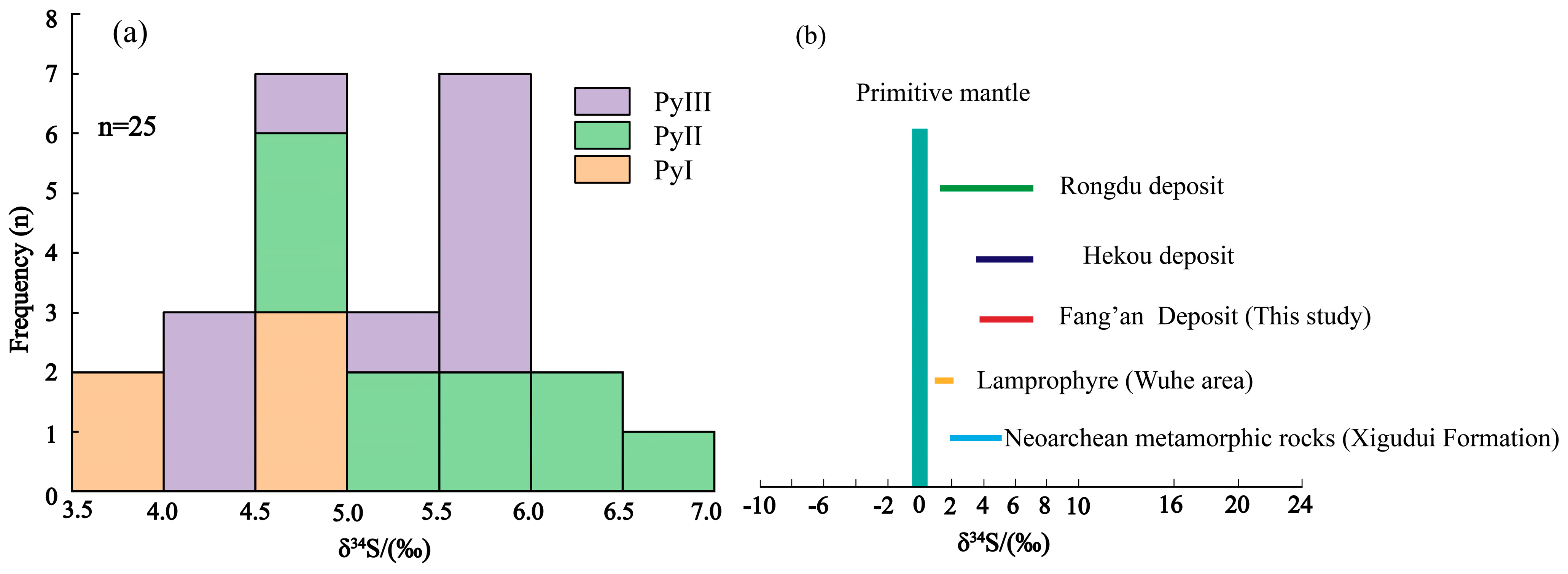

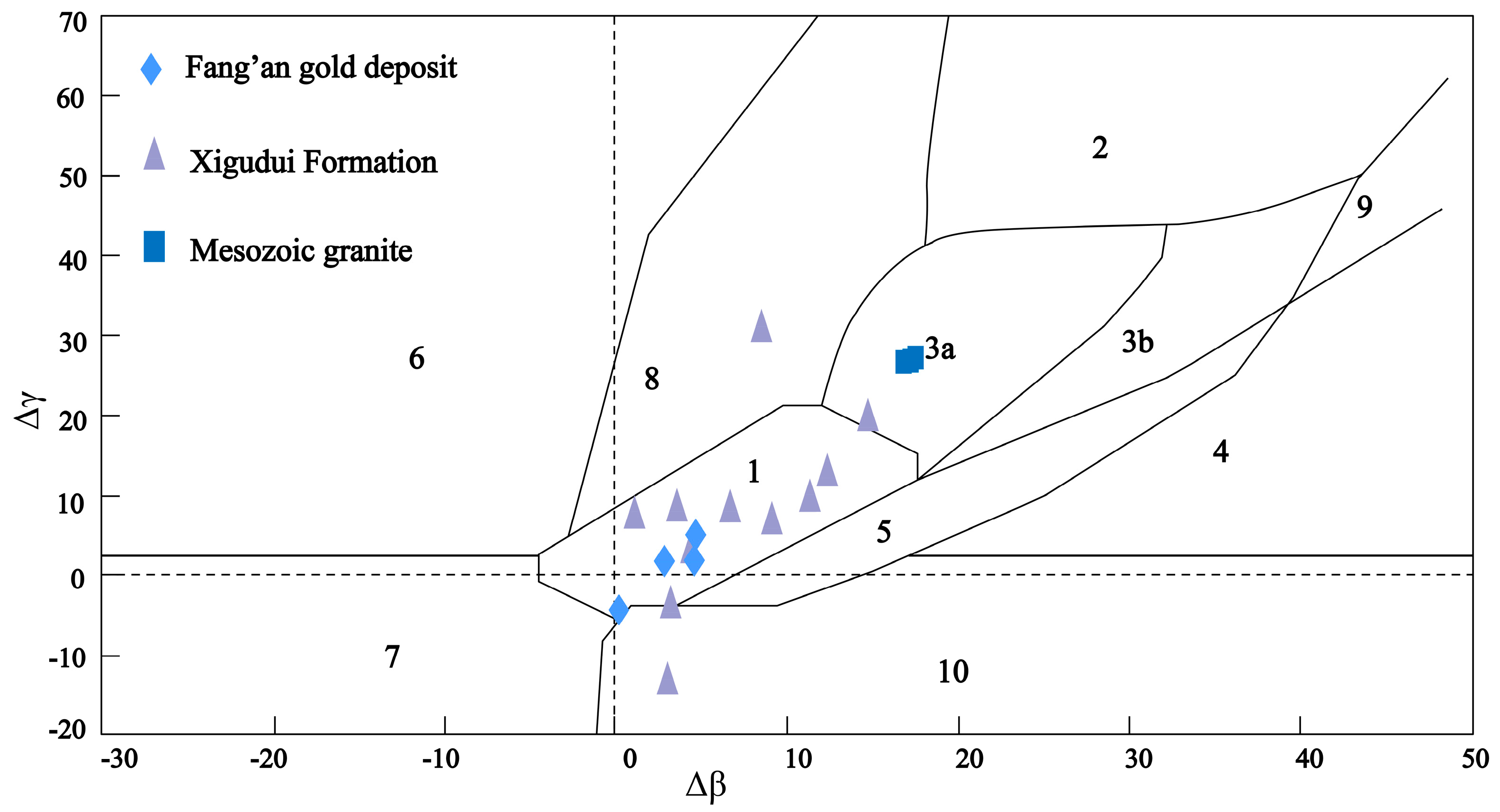
5.3. Ore Genesis
6. Conclusions
Author Contributions
Funding
Data Availability Statement
Conflicts of Interest
References
- Zhu, G.; Liu, G.S.; Niu, M.L.; Xie, C.L.; Wang, Y.S.; Xiang, B.W. Syn–collisional transform faulting of the Tan–Lu Fault zone, East China. Int. J. Earth Sci. 2009, 98, 135–155. [Google Scholar] [CrossRef]
- Zhai, M.; Li, T.S.; Peng, P. Precambrian key tectonic events and evolution of the North China craton. Geol. Soc. Lond. Spec. Publ. 2010, 338, 235–262. [Google Scholar] [CrossRef]
- Zhu, G.; Liu, C.; Gu, C.; Zhang, S.; Li, Y.; Su, N.; Xiao, S.Y. Oceanic plate subduction history in the western Pacifific Ocean: Constraint from late Mesozoic evolution of the Tan–Lu fault zone. China Earth Sci. 2018, 61, 386–405. [Google Scholar] [CrossRef]
- Liu, Z.; Ni, P.; Zhang, Y.Q. An Early Cretaceous gold metallogenesis in the Wuhe area, Eastern Anhui province: Constraints from geology, fluid inclusion, H–O isotope and geochronology on the Hekou gold deposit. Ore Geol. Rev. 2021, 138, 104319. [Google Scholar] [CrossRef]
- Li, C.; Yan, J.; Wang, A.G. Petrogenesis of Cretaceous granitoids in the Bengbu–Wuhe area, southeastern North China Craton: Implications for gold mineralization. Ore Geol. Rev. 2020, 126, 103740. [Google Scholar] [CrossRef]
- Wang, A.D.; Liu, Y.C.; Gu, X.F. Late–Neoarchean magmatism and metamorphism at the southeastern margin of the North China Craton and their tectonic implications. Precambrian Res. 2012, 220, 65–79. [Google Scholar] [CrossRef]
- Li, S.R.; Santosh, M. Geodynamics of heterogeneous gold mineralization in the North China Craton and its relationship to lithospheric destruction. Gondwana Res. 2017, 50, 267–292. [Google Scholar] [CrossRef]
- Liu, C.H.; Zhao, G.C.; Liu, F.L.; Cai, J. The southwestern extension of the Jiao–Liao–Ji belt in the North China Craton: Geochronological and geochemical evidence from the Wuhe Group in the Bengbu area. Lithos 2018, 304, 258–279. [Google Scholar] [CrossRef]
- Yang, Z. Metallogenic Geological Characteristics and Genesis of Gold Polymetallic Deposits in Bengbu Wuhe Area, Anhui Province. Master’s Thesis, Hefei University of Technology, Hefei, China, 2020. [Google Scholar]
- Shi, K.; Yang, X.Y.; Du, J.G. Geochemistry and Geochronology of Intermediate Rocks in the Jiangshan Au Deposit in the Bengbu Uplift, North Anhui Province: Clues to Regional Au Mineralization. Acta Geol. Sin. 2020, 94, 1909–1920. [Google Scholar] [CrossRef]
- Hu, H.F.; Xu, X.C.; Chen, F.; Xu, W. A comparison of metallogenic geological conditions of gold deposits between the Bengbu–Wuhe area in Anhui and Eastern Shandong Province. Geology 2015, 39, 187–193, (In Chinese with English Abstract). [Google Scholar]
- Wan, J.; Wang, A.; Pan, J. Episodic crustal growth and reworking at the southeastern margin of the North China Craton: Evidence from zircon U–Pb and Lu–Hf isotopes of Archean tonalite–trondhjemite–granodiorite gneisses in the Bengbu–Wuhe area. Acta Geochim. 2021, 40, 366–389. [Google Scholar] [CrossRef]
- Zhang, S.L.; Sheng, Z.L.; Wang, Q.S.; Zhang, J.J. Thoughts on several issues of gold–based prospecting in Wuhe area. Anhui Geol. 2017, 27, 256–262, (In Chinese with English abstract). [Google Scholar]
- Wei, B. Metallogenesis of the gold–lead–zinc polymetallic deposit and the genesis of the deposit in Bengbu, Anhui Province. Master’s Thesis, China University of Geosciences, Beijing, China, 2011. (In Chinese with English abstract). [Google Scholar]
- Chen, Y.; Fan, Y.; Zhou, T.F. Pyrite textures and compositions in Jiangshan gold deposit, Bengbu Uplift, southeastern North China Craton: Implications for ore genesis. Ore Geol. Rev. 2020, 122, 103512. [Google Scholar] [CrossRef]
- Wang, Y.; Xiong, L.; Zhong, Z.; Ren, S.; Zhang, G.; Wang, J.; Zhang, Y.; Song, C.Z. Typomorphic characteristics of gold–bearing pyrite and its genetic implications for the Fang’an gold deposit, the Bengbu uplift, eastern China. Minerals 2022, 12, 1196. [Google Scholar] [CrossRef]
- Yang, D.B.; Xu, W.L.; Wang, Q.H.; Pei, F.P. Chronology and geochemistry of Mesozoic granitoids in the Bengbu area, central China: Constraints on the tectonic evolution of the eastern North China Craton. Lithos 2010, 114, 200–216. [Google Scholar] [CrossRef]
- Guo, S.; Li, S. SHRIMP zircon U–Pb ages for the Paleoproterozoic metamorphic–magmatic events in the southeast margin of the North China Craton. Sci. China Ser. D Earth Sci. 2009, 52, 1039–1045. [Google Scholar] [CrossRef]
- Yang, D.B.; Xu, W.L.; Wang, Q.H.; Pei, F.P.; Ji, W.Q. Petrogenesis of Late Jurassic Jingshan granite in Bengbu Uplift, Anhui province: Constraints from geochemistry and Hf isotope of zircons. Acta Petrol. Sin. 2006, 22, 2923–2932. [Google Scholar]
- Yang, D.B.; Xu, W.L.; Pei, F.P.; Wang, Q.H.; Liu, X.M. Formation time and magma source of granites in Bengbu Uplift, Evidence from LA–ICPMS zircon U–Pb dating and tracing. Geochimica 2005, 34, 443–454, (In Chinese with English Abstract). [Google Scholar]
- Zhang, J.J.; Zhang, S.L.; Zhu, Y.K. Metallogenic geological conditions and metallogenic model of the Hekou Pb–Au deposit in the Wuhe area, Anhui Province. J. Geol. 2019, 1, 57–66. [Google Scholar]
- Li, Q.L.; Chen, F.K.; Yang, J.H.; Fan, H.R. Single grain pyrite Rb–Sr dating of the Linglong gold deposit, eastern China. Ore Geol. Rev. 2008, 34, 263–270. [Google Scholar] [CrossRef]
- Yang, Y.H.; Zhang, H.F.; Chu, Z.Y.; Xie, L.W.; Wu, F.Y. Combined chemical separation of Lu, Hf, Rb, Sr, Sm and Nd from a single rock digest and precise and accurate isotope determinations of Lu–Hf, Rb–Sr and Sm–Nd isotope systems using Multi–Collector ICP–MS and TIMS. Int. J. Mass Spectrom. 2010, 290, 120–126. [Google Scholar] [CrossRef]
- Wang, Y.X.; Gu, L.X.; Zhang, Z.Z.; Wu, C.Z.; Li, H.M.; Yang, J.D. Sr–Nd–Pb isotope geochemistry of rhyolite of the Late Carboniferous Dashitou Group in eastern Tianshan. Acta Petrol. Sin. 2007, 23, 1749–1755, (In Chinese with English abstract). [Google Scholar]
- Ludwig, K.R. ISOPLOT 3.0: A Geochronological Toolkit for Microsoft Excel; Berkeley Geochronology Center, Special Publications 4: Berkeley, CA, USA, 2003. [Google Scholar]
- Li, R.; Xia, X.; Yang, S.; Chen, H.; Yang, Q. Off-mount calibration and one new potential pyrrhotite reference material for sulfur isotope measurement by secondary ion mass spectrometry. Geostand. Geoanal. Res. 2019, 43, 177–187. [Google Scholar] [CrossRef]
- Crowe, D.E.; Vaughan, R.G. Characterization and use of isotopically homogeneous standards for in situ laser microprobe analysis of 34S/32 S ratios. Am. Mineral. 1996, 81, 187–193. [Google Scholar] [CrossRef]
- Wang, L.; Tang, J.; Bagas, L. Early Eocene Longmala skarn Pb–Zn–Cu deposit in Tibet, China: Geochemistry, fluid inclusions, and H–O–S–Pb isotopic compositions. Ore Geol. Rev. 2017, 88, 99–115. [Google Scholar] [CrossRef]
- Zong, W.; Kang, C.X.; Yang, X.Z. Tyomorphic characteristics and S–Pb isotopic composition of pyrite in the Qiantaizi gold deposit, Wuhe–Fengyang area, eastern Anhui Province. J. Geol. 2022, 46, 366–374, (In Chinese with English abstract). [Google Scholar]
- Liu, Z.; Ni, P.; Wang, G.G.; Zhang, Y.Q.; Sheng, Z.L.; Zhang, S.L.; Fan, M.S.; Zhao, Z.H. Hydrothermal evolution and gold precipitation mechanism of the Hekou gold deposit, North China Craton: Insights from pyrite texture, composition and in situ S isotope. Ore Geol. Rev. 2023, 156, 105387. [Google Scholar] [CrossRef]
- Chen, Y. Metallogenic and Model of Gold Deposits in Bengbu Uplift, Anhui Province, China. Ph.D. Thesis, Hefei University of Technology, Hefei, China, 2021. [Google Scholar]
- Yang, D.B. Chronology and Geochemistry of Granites in the Bengbu Uplift: Constraints on Tectonic Evolution of the Eastern North China Craton. Ph.D. Thesis, Jilin University, Changchun, China, 2009. [Google Scholar]
- Sang, B.L.; Tu, Y.J.; Chen, Y.Z. Study on the gold–bearing and metallogenic prospects of the Precambrian metamorphic rock system in Bengbu–Wuhe area, Anhui Province, 1990. Available online: https://www.ngac.cn/dzzlfw_sjgl/d2d/dse/category/detail.do?method=cdetail&_id=102_77672&tableCode=ty_qgg_edmk_t_ajxx&categoryCode=dzzlk (accessed on 11 April 2024). (In Chinese with English abstract).
- Dong, F.X.; Li, Z.J.; Chen, B.L. The Structure Control of Gold Deposits and Their Exploration in the Dagongshan–Rongdu Area of Wuhe County; Geological Publishing House: Beijing, China, 1995; (In Chinese with English abstract). [Google Scholar]
- Tu, Y.J.; Chen, C.T.; Tang, L.G. The classification and structural features of the Precambrian metamorphic rock series in the northern part of the Jianghuai region. Reg. Geol. China 1992, 3, 248–256, (In Chinese with English abstract). [Google Scholar]
- Tu, Y.J.; Li, J.S.; Chen, C.T. Metallogenic Conditions and Metallogenic Prediction of Wuhe Rongdu Gold Deposit in Anhui Province (Research Report in Chinese) 1993. (In Chinese with English abstract). Available online: https://www.ngac.cn/dzzlfw_sjgl/d2d/dse/category/detail.do?method=cdetail&_id=102_92018&tableCode=ty_qgg_edmk_t_ajxx&categoryCode=dzzlk (accessed on 11 April 2024).
- Lu, Y.F. Geokit—A geochemical toolkit for microsoft excel. Geochimica 2004, 5, 459–464, (In Chinese with English abstract). [Google Scholar]
- Leach, D.L.; Bradley, D.C.; Huston, D.; Pisarevsky, S.A.; Taylor, R.D.; Gardoll, S.J. Sediment–hosted lead–zinc deposits in Earth history. Econ. Geol. 2010, 105, 593–625. [Google Scholar] [CrossRef]
- Li, W.B.; Huang, Z.L.; Xu, D.R.; Chen, J.; Xu, C.; Guan, T. Rb–Sr isotopic method on zinc–lead ore deposits: A review. Geotecton. Metallog. 2002, 26, 436–441, (In Chinese with English abstract). [Google Scholar]
- Nakai, S.; Halliday, A.N.; Kesler, S.E.; Jones, H.D. Rb–Sr dating of sphalerites from Tennessee and the genesis of Mississippi Valley type ore deposits. Nature 1990, 346, 354–357. [Google Scholar] [CrossRef]
- Chen, F.; Zhu, X.Y.; Wang, W.; Wang, F.; Hieu, P.T.; Siebel, W. Single–grain detrital muscovite Rb–Sr isotopic composition as an indicator of provenance for the Carboniferous sedimentary rocks in northern Dabie, China. Geochem. J. 2009, 43, 257–273. [Google Scholar] [CrossRef]
- Kryza, R.; Pin, C.; Oberc–Dziedzic, T.; Crowley, Q.G.; Larionov, A. Deciphering the geochronology of a large granitoid pluton (Karkonosze Granite, SW Poland): An assessment of U–Pb zircon SIMS and Rb–Sr whole–rock dates relative to U–Pb zircon CA–ID–TIMS. Int. Geol. Rev. 2014, 56, 756–782. [Google Scholar] [CrossRef]
- Tian, S.H.; Gong, Y.L.; Yang, Z.S.; Hou, Z.Q.; Liu, Y.C.; Song, Y.C.; Xue, W.W.; Lu, H.F.; Wang, F.C.; Zhang, Y.B.; et al. Rb-Sr and Sm-Nd Isochron Ages of the Dongmozhazhua and Mohailaheng Pb-Zn Ore Deposits in the Yushu area, southern Qinghai and Their Geological Implications. Acta Geol. Sin.-Engl. Ed. 2014, 88, 558–569. [Google Scholar] [CrossRef]
- Li, C.; Jun, Y. Tectono-magmatic control on the intensity of decratonic gold mineralization in the southeastern margin of the North China Craton: A perspective from geochemical comparison. Int. Geol. Rev. 2024, 66, 582–606. [Google Scholar] [CrossRef]
- Hayashi, K.I.; Ohmoto, H. Solubility of gold in NaCl–and H2S–bearing aqueous solutions at 250–350 °C. Geochim. Et Cosmochim. Acta 1991, 55, 2111–2126. [Google Scholar] [CrossRef]
- Loucks, R.R.; Mavrogenes, J.A. Gold solubility in supercritical hydrothermal brines measured in synthetic fluid inclusions. Science 1999, 284, 2159–2163. [Google Scholar] [CrossRef] [PubMed]
- Kesler, S.E.; Riciputi, L.C.; Ye, Z.J. Evidence for a magmatic origin for Carlin–type gold deposits: Isotopic composition of sulfur in the Betze–Post–Screamer deposit, Nevada, USA. Miner. Depos. 2005, 40, 127–136. [Google Scholar] [CrossRef]
- Chang, Z.S.; Large, R.R.; Maslennikov, V. Sulfur isotopes in sediment–hosted orogenic gold deposits: Evidence for an early timing and a seawater sulfur source. Geology 2008, 36, 971–974. [Google Scholar] [CrossRef]
- Cai, Y.C.; Fan, H.R.; Santosh, M.; Hu, F.F.; Yang, K.F.; Li, X.H. Decratonic gold mineralization: Evidence from the Shangzhuang gold deposit, eastern North China Craton. Gondwana Res. 2018, 54, 1–22. [Google Scholar] [CrossRef]
- Groves, D.I.; Goldfarb, R.J.; Robert, F.; Craig, J.R. Gold deposits in metamorphic belts: Overview of current understanding, outstanding problems, future research, and exploration significance. Econ. Geol. 2003, 98, 1–29. [Google Scholar]
- Mao, J.W.; Wang, Y.T.; Li, H.M.; Pirajno, F.; Zhang, C.Q.; Wang, R.T. The relationship of mantle–derived fluids to gold metallogenesis in the Jiaodong Peninsula: Evidence from D–O–C–S isotope systematics. Ore Geol. Rev. 2008, 33, 361–381. [Google Scholar] [CrossRef]
- Zhu, R.X.; Fan, H.R.; Li, J.W.; Meng, Q.R.; Li, S.R.; Zeng, Q.D. Decratonic gold deposits. Sci. China Earth Sci. 2015, 58, 1523–1537. [Google Scholar] [CrossRef]
- Bierlein, F.P.; McNaughton, N.J. Pb isotope fingerprinting of mesothermal gold deposits from central Victoria, Australia: Implications for ore genesis. Miner. Depos. 1998, 33, 633–638. [Google Scholar] [CrossRef]
- Qiu, Y.; McNaughton, N.J. Source of Pb in orogenic lode–gold mineralisation: Pb isotope constraints from deep crustal rocks from the southwestern Archaean Yilgarn craton, Australia. Miner. Depos. 1999, 34, 366–381. [Google Scholar] [CrossRef]
- Zhong, S.H.; Feng, C.Y.; Seltmann, R.; Dolgopolova, A.; Andersen, J.C.Ø.; Li, D.X.; Yu, M. Sources of fluids and metals and evolution models of skarn deposits in the Qimantagh metallogenic belt: A case study from the Weibao deposit, East Kunlun Mountains, northern Tibetan Plateau. Ore Geol. Rev. 2018, 93, 19–37. [Google Scholar] [CrossRef]
- Li, Y.; Li, Q.-L.; Yang, J.-H. Tracing water–rock interaction in carbonate replacement deposits: A SIMS pyrite S–Pb isotope perspective from the Chinese Xinqiao system. Ore Geol. Rev. 2019, 107, 248–257. [Google Scholar] [CrossRef]
- Zartman, R.E.; Doe, B.R. Plumbotectonics—The model. Tectonophysics 1981, 75, 135–162. [Google Scholar] [CrossRef]
- Deng, J.; Wang, Q.F.; Li, G.J.; Santosh, M. Cenozoic tectono–magmatic and metallogenic processes in the Sanjiang region, southwestern China. Earth–Sci. Rev. 2014, 138, 268–299. [Google Scholar] [CrossRef]
- Lee, J.H.; Yoo, B.C.; Yang, Y.-S.; Lee, T.H.; Seo, J.H. Sphalerite geochemistry of the Zn–Pb orebodies in the Taebaeksan metallogenic province, Korea. Ore Geol. Rev. 2019, 107, 1046–1067. [Google Scholar] [CrossRef]
- Wu, K.X.; Hu, R.Z.; Bi, X.W.; Peng, J.T. Ore lead isotopes as a tracer for ore–forming material sources: A review. Geol.–Geochem. 2002, 30, 73–81. [Google Scholar]
- Doe, B.R.; Stacey, J.S. The Application of Lead Isotopes to the Problems of Ore Genesis and Ore Prospect Evaluation: A Review. Econ. Geol. 1974, 69, 757–776. [Google Scholar] [CrossRef]
- Doe, B.R.; Zartman, R.E. Plumbotectonics I: The Phanerozoic. In Geochemistry of Hydrothermal Ore Deposits; Barnes, H.L., Ed.; John Wiley & Sons: Hoboken, NJ, USA, 1979; pp. 22–70. [Google Scholar]
- Kamona, A.F.; Leveque, J.; Friedrich, G.; Haack, U. Lead isotopes of the carbonatehosted Kabwe, Tsumeb, and Kipushi Pb–Zn–Cu sulphide deposits in relation to Pan African orogenesis in the Damaran–Lufilian Fold Belt of Central Africa. Miner. Depos. 1999, 34, 273–283. [Google Scholar] [CrossRef]
- Mirnejad, H.; Simonetti, A.; Molasalehi, F. Pb isotopic compositions of some Zn–Pb deposits and occurrences from Urumieh–Dokhtar and Sanandaj–Sirjan zones in Iran. Ore Geol. Rev. 2011, 39, 181–187. [Google Scholar] [CrossRef]
- Kyser, T.K. Stable isotope variations in the mantle. In Stable Isotopes in High Temperature Geological Processes; Valley, J.W., Taylor, H.P., Jr., O’Neil, J.R., Eds.; Reviews in Mineralogy and Geochemistry; Mineralogical Society of America: Washington, DC, USA, 1986; Volume 16, pp. 141–164. [Google Scholar]
- Stacey, J.S.; Kramers, J.D. Approximation of terrestrial lead isotope evolution by a two–stage model. Earth Planet. Sci. Lett. 1975, 26, 207–221. [Google Scholar]
- Zartman, R.E.; Haines, S.M. The plumbotectonic model for Pb isotopic systematics among major terrestrial reservoirs—A case for bi–directional transport. Geochim. Cosmochim. Acta 1988, 52, 1327–1339. [Google Scholar] [CrossRef]
- Zhu, B.Q. Theory and Application of Isotope System in Earth Sciences–also on Crust–Mantle Evolution in Mainland China; Science Press: Beijing, China, 1998; pp. 1–330. [Google Scholar]
- Zhang, Y.Q.; Dong, S.W. Mesozoic tectonic evolution history of the Tan–Lu fault zone, China: Advances and new understanding. Geol. Bull. China 2008, 27, 1371–1390, (In Chinese with English abstract). [Google Scholar]
- Zhu, R.X.; Xu, Y.G.; Zhu, G.; Zhang, H.F.; Xia, Q.K.; Zheng, T.Y. Destruction of the North China Craton. Sci. China Earth Sci. 2012, 55, 1565–1587. [Google Scholar] [CrossRef]
- Ma, L.; Jiang, S.Y.; Hofmann, A.W.; Xu, Y.G.; Dai, B.Z.; Hou, M.L. Rapid lithospheric thinning of the North China Craton: New evidence from Cretaceous mafic dikes in the Jiaodong Peninsula. Chem. Geol. 2016, 432, 1–15. [Google Scholar] [CrossRef]
- Ionov, D.A.; Hoefs, J.; Wedepohl, K.H.; Wiechert, U. Concentration and isotopic composition of sulfur in ultramafic xenoliths from Central Asia. Earth Planet. Sci. Lett. 1992, 111, 269–286. [Google Scholar] [CrossRef]
- Rye, R.O. The evolution of magmatic fluids in the epithermal environment; the stable isotope perspective. Econ. Geol. 1993, 88, 733–752. [Google Scholar] [CrossRef]
- Ohmoto, H. Systematics of sulfur and carbon isotopes in hydrothermal ore deposits. Econ. Geol. 1972, 67, 551–578. [Google Scholar] [CrossRef]
- Roedder, E. Fluid inclusions. Rev. Mineral. 1984, 12, 644. [Google Scholar]
- Lu, H.Z.; Fan, H.R.; Ni, P.; Ou, G.X.; Shen, K.; Zhang, W.H. Fluid Inclusion; Science623 Press: Beijing, China, 2004. [Google Scholar]
- Reed, M.H.; Palandri, J. Sulfide mineral precipitation from hydrothermal fluids. Rev. Mineral. Geochem. 2006, 61, 609–631. [Google Scholar] [CrossRef]
- Skinner, B.J. Hydrothermal mineral deposits: What we do and don ’t know. In Geochemistry of Hydrothermal Ore Deposits; John Wiley & Sons: New York, NY, USA, 1997; pp. 1–26. [Google Scholar]
- Simmons, S.F.; Brown, K.L. Gold in magmatic hydrothermal solutions and the rapid formation of a giant ore deposit. Science 2006, 314, 288–291. [Google Scholar] [CrossRef] [PubMed]
- Sakai, H. Isotopic properties of sulfur compounds in hydrothermal processes. Geochem. J. 1968, 2, 29–49. [Google Scholar] [CrossRef]
- Seal, R.R. Sulfur isotope geochemistry of sulfide minerals. Rev. Mineral. Geochem. 2006, 61, 633–677. [Google Scholar] [CrossRef]

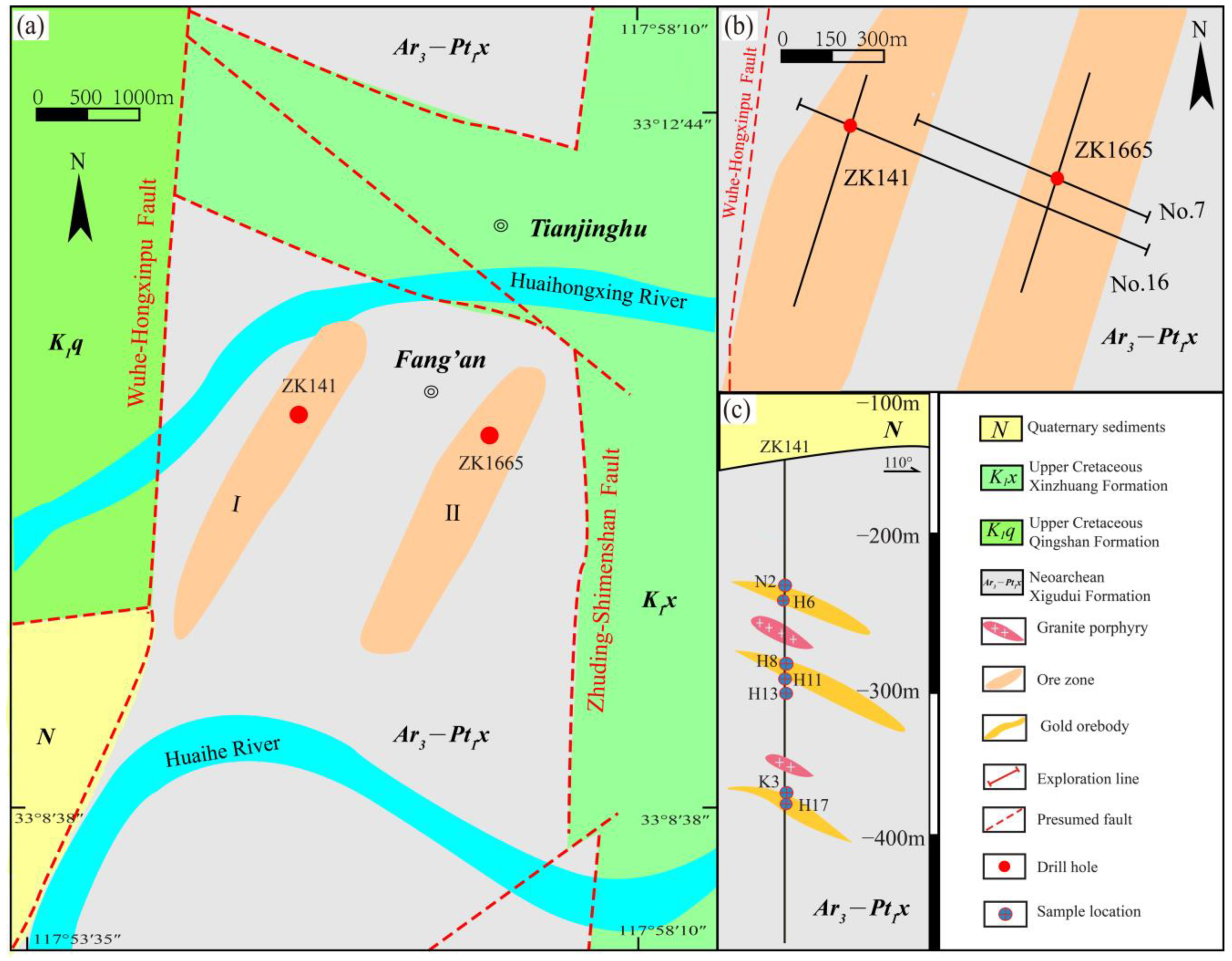
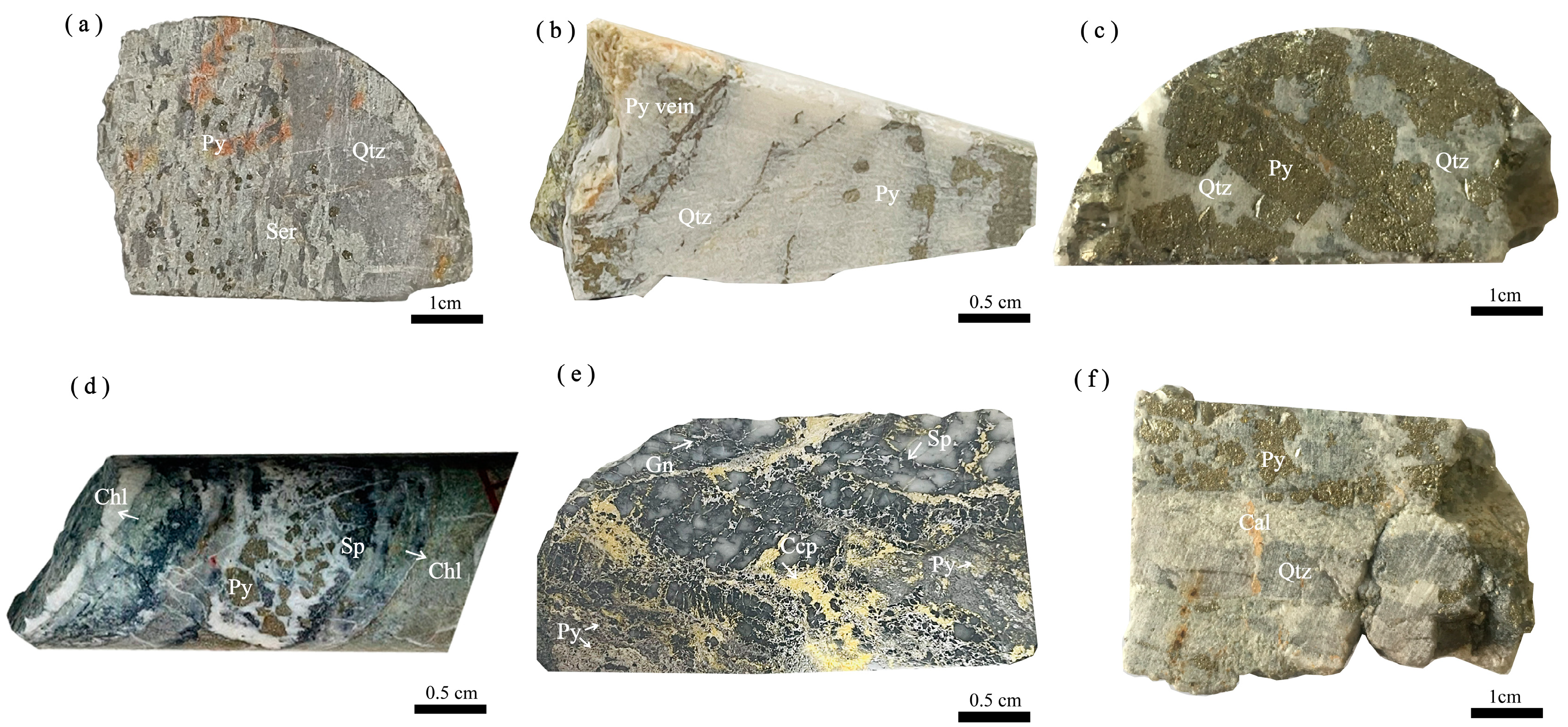

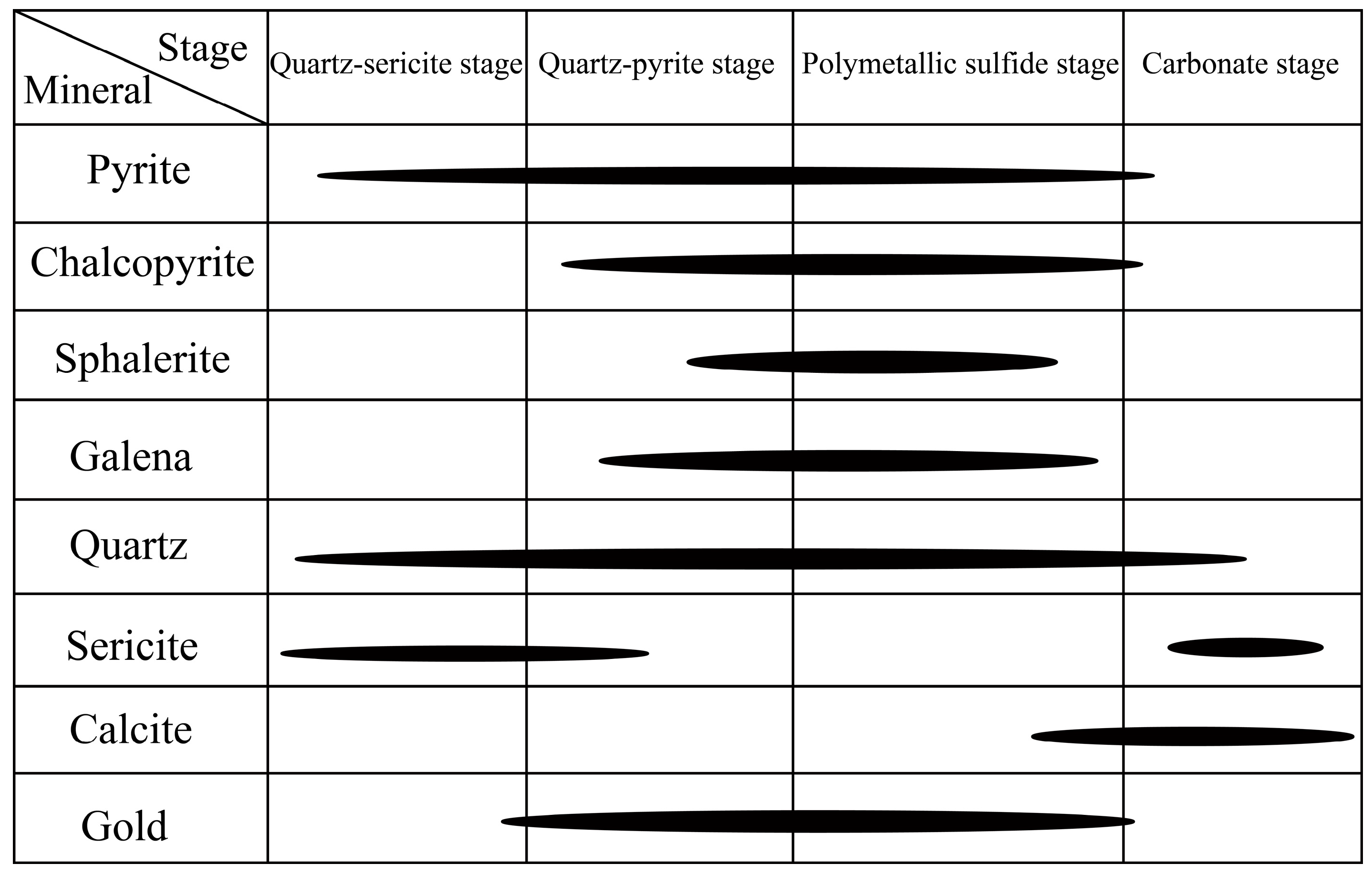

| Sample | Rb (×10−6) | Sr (×10−6) | 87Rb/86Sr | 87Sr/86Sr | Std Err |
|---|---|---|---|---|---|
| ZK141–H8 | 0.182 | 0.482 | 1.0941 | 0.715128 | 0.000029 |
| ZK141–H11 | 2.53 | 0.905 | 8.0946 | 0.727487 | 0.000024 |
| ZK141–N2 | 1.75 | 9.46 | 0.5361 | 0.714043 | 0.000023 |
| Site | Sample No. | Testing Object | δ34Sv–CDT/‰ | References |
|---|---|---|---|---|
| Fang’an | ZK141–H11–1 | Py1 | 3.73 | This study |
| ZK141–H11–2 | 4.95 | |||
| ZK141–H11–3 | 4.81 | |||
| ZK141–H11–4 | 3.84 | |||
| ZK141–H11–5 | 4.93 | |||
| ZK141-K3–1–1 | Py2 | 5.86 | ||
| ZK141-K3–1–2 | 6.81 | |||
| ZK141-K3–1–3 | 6.09 | |||
| ZK141-K3–1–4 | 5.69 | |||
| ZK141-K3–1–5 | 6.12 | |||
| ZK1665–F4–2–2 | 5.31 | |||
| ZK1665–F4–2–3 | 4.55 | |||
| ZK1665–F4–2–4 | 4.69 | |||
| ZK1665–F4–2–5 | 4.84 | |||
| ZK1665–F4–2–6 | 5.11 | |||
| ZK1665–F4–1–4 | Py3 | 4.78 | ||
| ZK1665–F4–1–5 | 4.49 | |||
| ZK1665–F4–1–3 | 4.09 | |||
| ZK1665–F4–1–6 | 4.5 | |||
| ZK141–H1–1 | 5.66 | |||
| ZK141–H1–2 | 5.53 | |||
| ZK141–H1–3 | 5.66 | |||
| ZK141–H1–4 | 5.49 | |||
| ZK141–H1–5 | 5.9 | |||
| ZK141–H1–6 | 5.7 | |||
| Rongdu | Galena | 2.3 | Wei (2011) [14] | |
| Pyrite | 2.5 | |||
| 6.8 | ||||
| Galena | 3.1 | |||
| DQT–Py–1 | Pyrite | 6.8 | Zong et al. (2022) [29] | |
| DQT–Py–2 | 5.8 | |||
| DQT–Gn–1 | Galena | 3.7 | ||
| DQT–Gn–2 | 1.3 | |||
| Hekou | 1 | Barren Pyrite | 6.47 | Liu et al. (2023) [30] |
| 2 | 6.33 | |||
| 3 | 6.29 | |||
| 4 | 6.37 | |||
| 5 | 6.12 | |||
| 6 | 6.24 | |||
| 7 | 6.07 | |||
| 8 | 6.02 | |||
| 9 | 5.98 | |||
| 10 | 6 | |||
| 11 | 6.2 | |||
| 12 | 6.19 | |||
| 13 | 6.47 | |||
| 14 | 6.58 | |||
| 15 | 6.51 | |||
| 16 | 6.73 | |||
| 1 | Auriferous Pyrite | 6.08 | ||
| 2 | 6.1 | |||
| 3 | 5.81 | |||
| 4 | 5.77 | |||
| 5 | 5.83 | |||
| 6 | 6.17 | |||
| 7 | 5.74 | |||
| 8 | 5.73 | |||
| 9 | 5.65 | |||
| 10 | 5.74 | |||
| 11 | 5.97 | |||
| 12 | 6.08 | |||
| 13 | 6.4 | |||
| 14 | 6.18 | |||
| Dykes | 2011–47 | Lamprophyre | 2.1 | Yang (2020) [9] |
| 2011–50 | 1.1 | |||
| Xigudui | RD–10 | Plagiogneiss | 4.1 | |
| DGS–17 | 4 | |||
| 2207–5 | 4.4 | |||
| 2011–18 | Amphibolite | 2 | ||
| Pyrite | 4.22 | Chen (2021) [31] | ||
| 4.77 | ||||
| 4.33 | ||||
| 5.63 | ||||
| 4.65 |
Disclaimer/Publisher’s Note: The statements, opinions and data contained in all publications are solely those of the individual author(s) and contributor(s) and not of MDPI and/or the editor(s). MDPI and/or the editor(s) disclaim responsibility for any injury to people or property resulting from any ideas, methods, instructions or products referred to in the content. |
© 2024 by the authors. Licensee MDPI, Basel, Switzerland. This article is an open access article distributed under the terms and conditions of the Creative Commons Attribution (CC BY) license (https://creativecommons.org/licenses/by/4.0/).
Share and Cite
Wang, Y.; Shi, K.; Zhong, Z.; Ren, S.; Wang, J.; Zhang, Y.; Song, C.; Zhang, G.; Ren, F. Rb–Sr Pyrite Dating and S–Pb Isotopes in the Fang’an Gold Deposit, Wuhe Area, Eastern Anhui Province. Minerals 2024, 14, 398. https://doi.org/10.3390/min14040398
Wang Y, Shi K, Zhong Z, Ren S, Wang J, Zhang Y, Song C, Zhang G, Ren F. Rb–Sr Pyrite Dating and S–Pb Isotopes in the Fang’an Gold Deposit, Wuhe Area, Eastern Anhui Province. Minerals. 2024; 14(4):398. https://doi.org/10.3390/min14040398
Chicago/Turabian StyleWang, Ying, Ke Shi, Ze Zhong, Shenglian Ren, Juan Wang, Yan Zhang, Chuanzhong Song, Gang Zhang, and Fangyu Ren. 2024. "Rb–Sr Pyrite Dating and S–Pb Isotopes in the Fang’an Gold Deposit, Wuhe Area, Eastern Anhui Province" Minerals 14, no. 4: 398. https://doi.org/10.3390/min14040398
APA StyleWang, Y., Shi, K., Zhong, Z., Ren, S., Wang, J., Zhang, Y., Song, C., Zhang, G., & Ren, F. (2024). Rb–Sr Pyrite Dating and S–Pb Isotopes in the Fang’an Gold Deposit, Wuhe Area, Eastern Anhui Province. Minerals, 14(4), 398. https://doi.org/10.3390/min14040398





